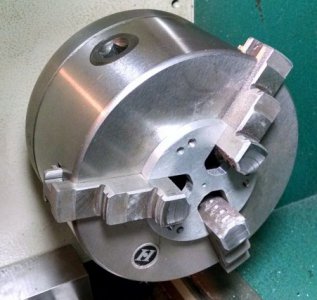-
Welcome back Guest! Did you know you can mentor other members here at H-M? If not, please check out our Relaunch of Hobby Machinist Mentoring Program!
You are using an out of date browser. It may not display this or other websites correctly.
You should upgrade or use an alternative browser.
You should upgrade or use an alternative browser.
Enlarging Hole In Washer
- Thread starter Splat
- Start date
- Joined
- Jan 22, 2011
- Messages
- 8,031
All depending on the chuck, like how large the bevels are on the front inside edge and whether the faces of the jaws run true......I use 3 pot magnets to hold the washer true to the face of the jaws while I just snug it down and then bore it. Kind if have to be gentle with it, but it's accurate.
- Joined
- Mar 19, 2014
- Messages
- 2,681
Hold the thin side of the washer in a bench vise. Then run a Unibit through the hole…Dave
- Joined
- Sep 29, 2014
- Messages
- 2,102
Depending on the thickness, hard chuck jaws have serrations, chuck the OD in the grooves and drill, ream or bore.
If that method is too crude turn a pocket in soft jaws and bore away, job done. This method will also allow to do any backwork such a a chamfer if required.
If that method is too crude turn a pocket in soft jaws and bore away, job done. This method will also allow to do any backwork such a a chamfer if required.
- Joined
- Dec 20, 2012
- Messages
- 9,422
I stick the washer to the face of a magnet larger than the washer. Bring the magnet to the face of a 3-jaw chuck and stick the magnet to the tips of the jaws. As you tighten the jaws the washer stays aligned in the jaws so it will run true when you've tightened it.
Sometimes the washer is too thin to clamp with the tips of the jaws, in which case I stack a few smaller washers underneath the one to be drilled and do the above. This gets the target washer deeper in the jaws while still keeping it aligned.
Then if the washer is thick enough, I drill it. If it is thin, I bore it. Hasn't failed yet.
Sometimes the washer is too thin to clamp with the tips of the jaws, in which case I stack a few smaller washers underneath the one to be drilled and do the above. This gets the target washer deeper in the jaws while still keeping it aligned.
Then if the washer is thick enough, I drill it. If it is thin, I bore it. Hasn't failed yet.
- Joined
- Feb 1, 2015
- Messages
- 9,605
- Joined
- Sep 25, 2014
- Messages
- 1,111
Many good responses here. All will work fine (depending on what it is you are trying to do). Trim soft jaws.
I wanted a shim under my QCTP (3" OD, 1" ID, relieved in the middle and 0.05" thick at the rim). I trimmed my soft jaws to a very small step, leaving the ID portion of the jaws larger than that 1" hole for the ID. I started by roughing a washer out of a piece of bar and about 1/8" thick. Then into the trimmed soft jaws and took small cuts with a keen tool (lots of positive rake). The washer turned out very well. I think one could go quite a bit thinner, but the work will deflect away between each jaw (may need to go to a pie shaped soft jaw for very thin items - unless you can grind it).
Anyway, the point being there are quite a number of approaches to machining washers. Good luck.
I wanted a shim under my QCTP (3" OD, 1" ID, relieved in the middle and 0.05" thick at the rim). I trimmed my soft jaws to a very small step, leaving the ID portion of the jaws larger than that 1" hole for the ID. I started by roughing a washer out of a piece of bar and about 1/8" thick. Then into the trimmed soft jaws and took small cuts with a keen tool (lots of positive rake). The washer turned out very well. I think one could go quite a bit thinner, but the work will deflect away between each jaw (may need to go to a pie shaped soft jaw for very thin items - unless you can grind it).
Anyway, the point being there are quite a number of approaches to machining washers. Good luck.
- Joined
- Feb 2, 2013
- Messages
- 3,627
my method for drilling washers is crude, but effective.
i'll grind a small flat on the washers' od and chuck it up in a vise, that way it won't spin on you.
i'll use a drill of the size i'd like and go to town.
i'll finish with a tapered reamer to remove any raised metal from the drilling operation.
i'll grind a small flat on the washers' od and chuck it up in a vise, that way it won't spin on you.
i'll use a drill of the size i'd like and go to town.
i'll finish with a tapered reamer to remove any raised metal from the drilling operation.


